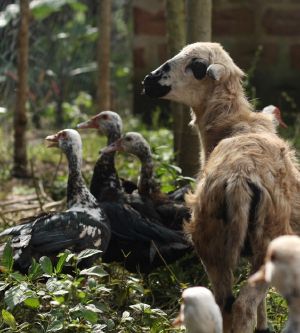Combining agriculture and livestock farming in Africa
It involves practicing agriculture and livestock farming together and establishing a link between the two practices in terms of complementarity.
Context
This practice is recommended in the following situations:
- Poor soil due to a lack of organic fertilizers of animal origin.
- Limited diversity in the diet, mainly plant-based.
- Underutilized by-products from crops.
- Limited diversity in income sources.
Ecological scope and benefits
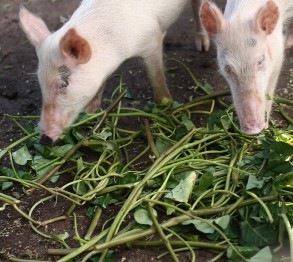
The combination of agriculture and livestock farming is interesting for the following reasons:
- Animals can be fed with crop residues and other by-products, and they can also consume pests or weeds, for example.
- Animal production complementary to plant production is beneficial for both sale and family consumption (diversification of income and/or diet).
- The recycling of animal manure (as well as bones and feathers) helps to maintain soil fertility and improve agricultural yields.
- Animals can also contribute to plowing and preparing the land before cultivation, saving some work for farmers.
Manure is particularly recommended for improving soil fertility that has been degraded by intensive cultivation[1]. It helps increase organic matter and provides the nutrients necessary for crops[2]. However, its direct use as fertilizer can have drawbacks. Manure can have a bad smell and attract flies or other pests. Moreover, in this form, significant nitrogen losses are possible[3]. It is therefore preferable to use it in composted form.
The bones of animals (and fish remains) can also be cooked and ground for use as fertilizer because they are rich in phosphorus pentoxide (P2O5)[4].
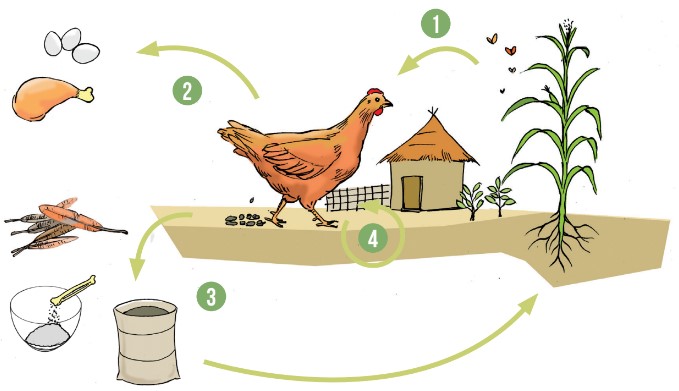
Prerequisites
- Adequate space and time availability for both agriculture and livestock practices.
- Competence and expertise.
- Availability of animals (poultry, cattle, etc.).
- Effective planning.
Necessary equipment

There is no specific equipment for this practice, as it relies on both agricultural and livestock equipment. As an indicative list, here is the necessary equipment for livestock and its role:
- Poultry house/sheepfold: Shelter/habitat.
- Containers, buckets: Water and feed storage.
- Feeders, waterers: Feeding the animals.
- Nesting box and perch: Laying and resting for poultry.
- Shovel, rake: Cleaning shelters and handling manure.
- Boots: Foot protection.
- Face mask: Nose protection.
- Footbaths: Foot disinfection.
- Broom: Shelter cleaning.
- Pruner: Hoof care.
- Blade: Castration.
- Alcohol and cotton: Disinfection before and after castration and other treatments.
- Vaccination equipment: Vaccination.
- Heater/heating: Warming young chicks.
Materials/Raw Materials
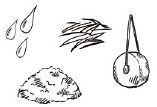
- Feed: Maize, rice, sorghum, locust bean flour, leftover meals.
- Water.
- If necessary, salt lick to provide missing nutrients to the feed.
- Heating materials.
Implementation Steps
The steps listed below take into account the principle that agriculture is already being practiced.
- Determine the animals to raise and ensure the availability of feed.
- Acquire the equipment.
- Identify the location of the chicken coop, enclosure, or sheepfold.
- Construct the chicken coop, enclosure, or sheepfold.
- Obtain the animals.
- Ensure the maintenance and monitoring of the livestock:
- Ensure regular, diverse, and sufficient feeding.
- Castration and vaccination according to the type of breeding (e.g., castration of old males, castration of young ones for rapid fattening, etc.).
- Warming of chicks separated from mother hens.
- Collect waste (dung, droppings, excrements) and valorize them.
- Gather agricultural by-products and use them to feed the animals.
Manure composting
Manure can be incorporated into compost production or composted alone:
- Harvest the manure, place it in the shade, and make a pile by moistening it.
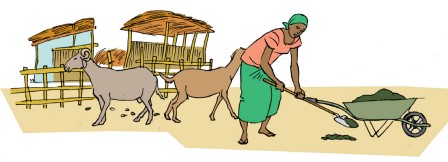
- Cover the pile with straw.
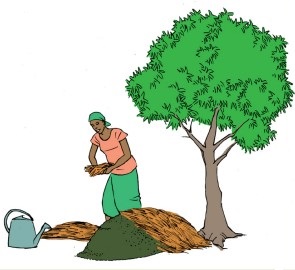
- Turn the pile after 2 weeks.
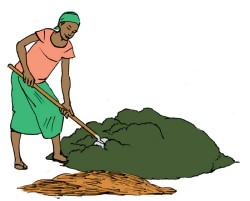
Once the manure has cooled, it can be used directly or stored for later use.
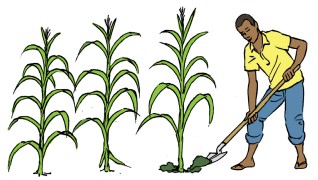
How to use: The manure can be spread on the land with the same dosage as for compost.
Challenges and constraints
- Lack of expertise in livestock techniques.
- Poor time management between livestock rearing and crop cultivation.
- Water and forage shortages.
- Limited access to veterinary products.
- Frequent diseases and deaths among the animals.
Sources
Manuel des bonnes pratiques agroécologiques - SECAAR.
This page was written in partnership with the Urbane project and with the financial support of the European Union.
